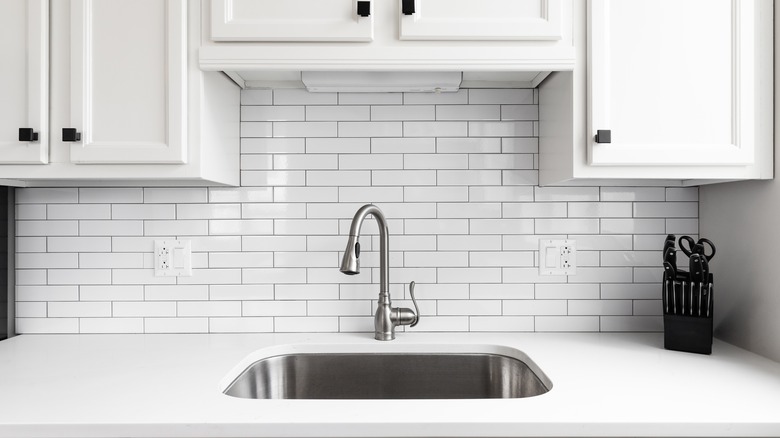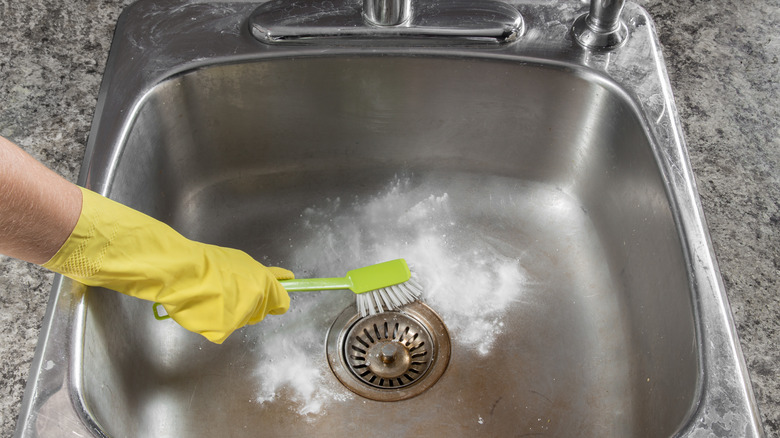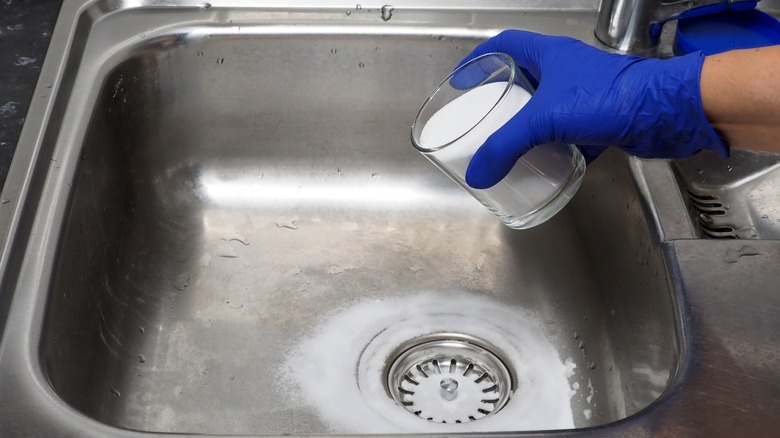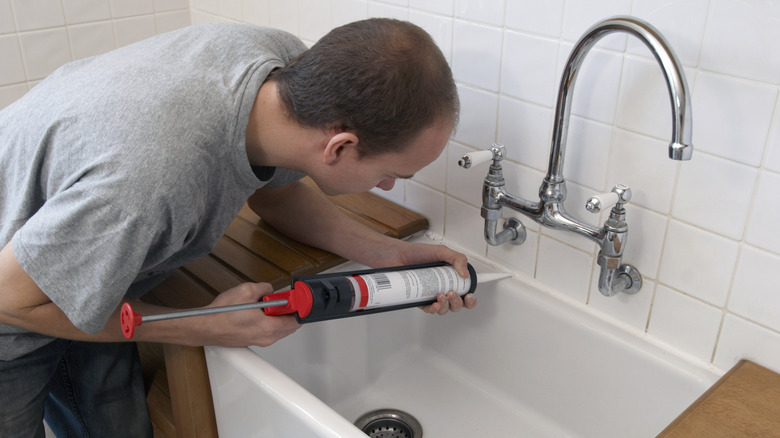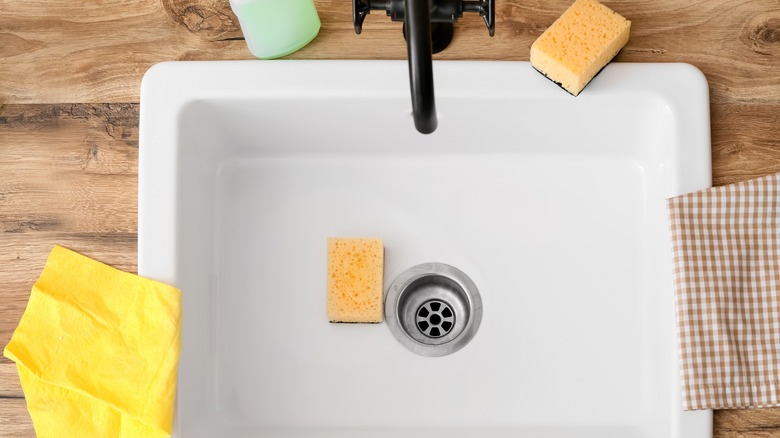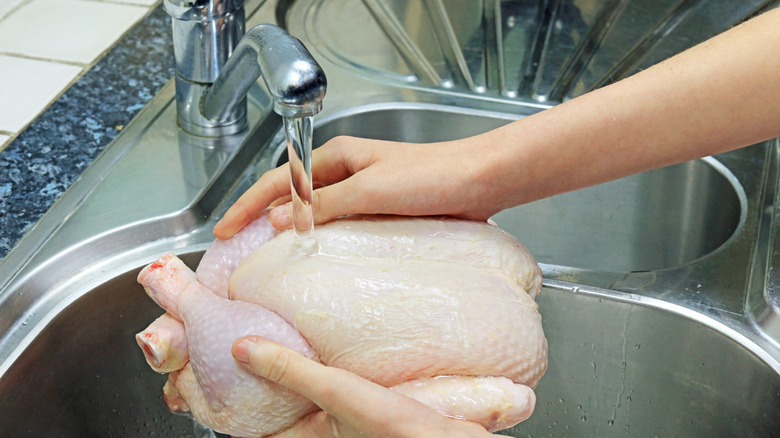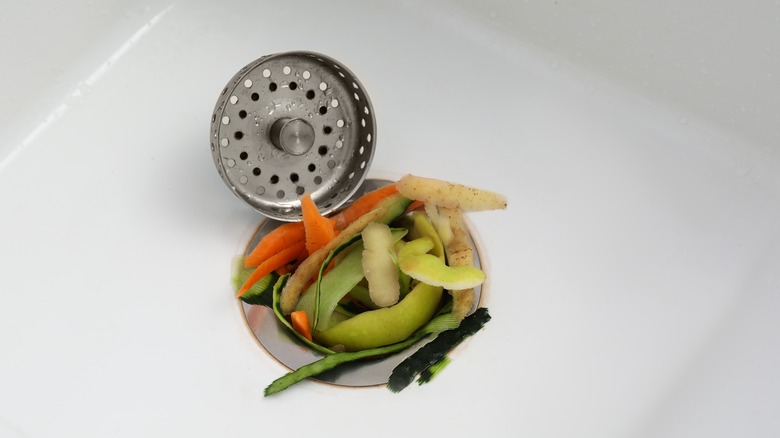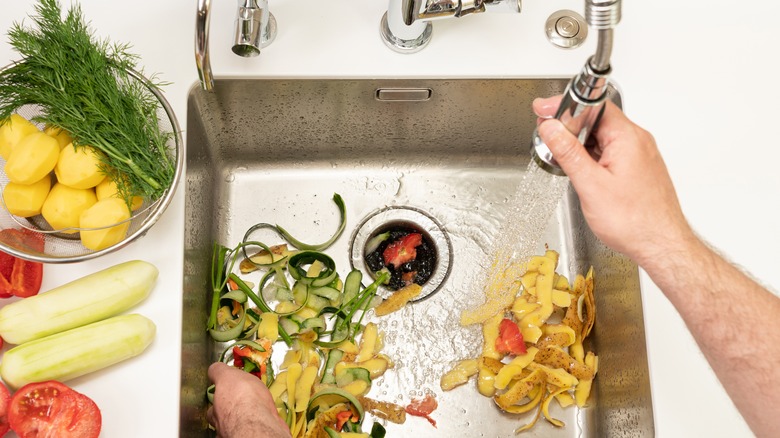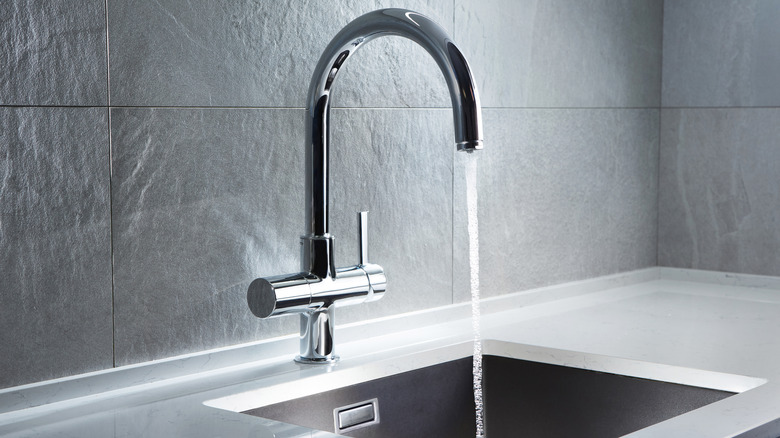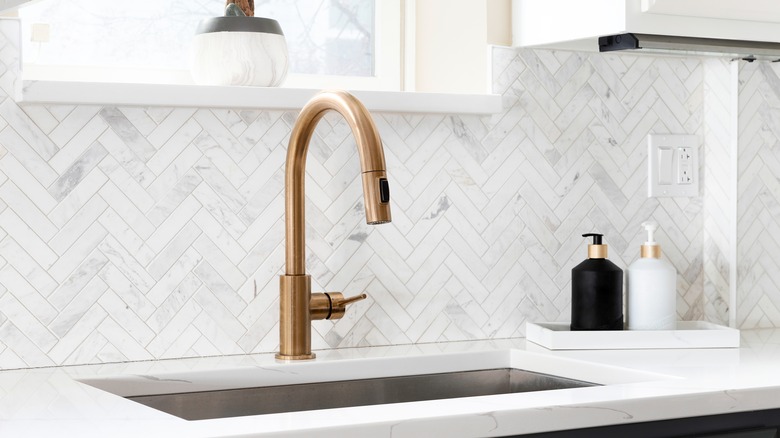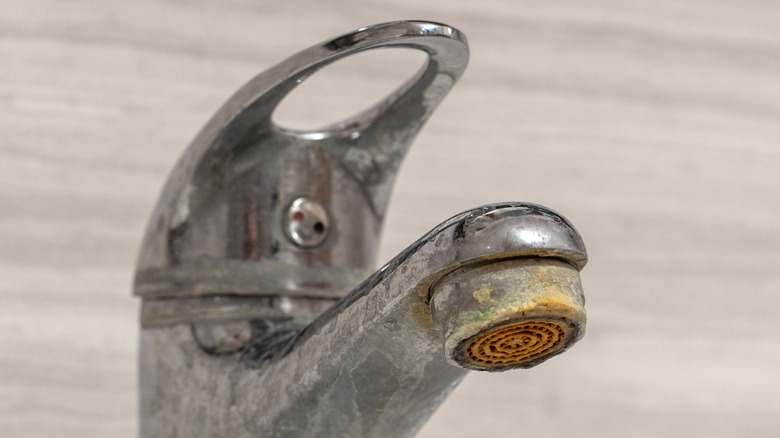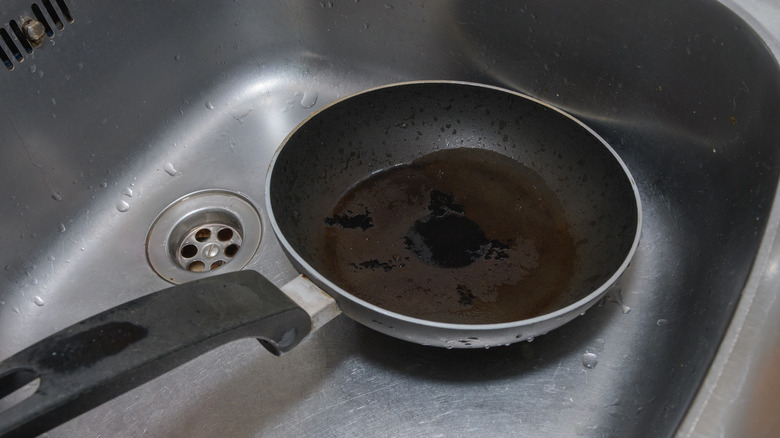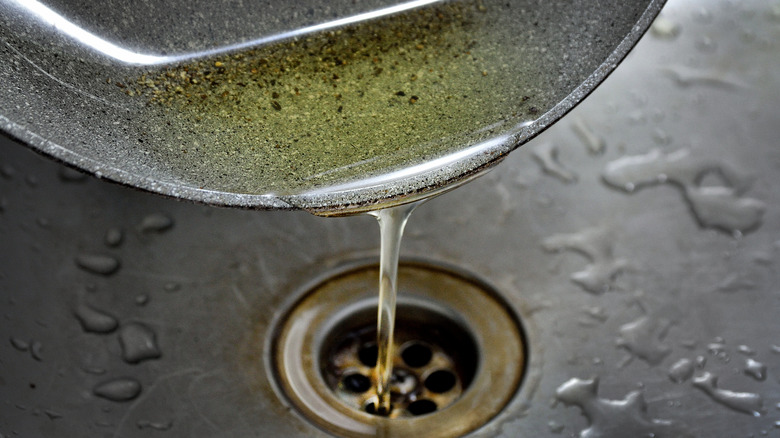Mistakes Everyone Makes With Their Kitchen Sink
The sink is an essential part of every kitchen. We use our kitchen sinks for everything from washing our hands to cleaning dishes to defrosting foods. Without a sink, a kitchen wouldn't be anywhere near as functional. Can you imagine cleaning your dishes in the bathroom or having to run to another room to wash your hands after handling raw meat while preparing a meal?
However, as essential as our kitchen sinks are, people make several common mistakes when using them that could potentially threaten safety, functionality, efficiency, and more. We all consider them intuitive and straightforward to use, but that isn't always the case. The way you use yours could be spreading germs and bacteria, increasing the chances of your pipes getting clogged, creating an environment where mold will be more likely to grow, threatening the structural integrity of your cabinets, or creating an eyesore in your otherwise updated and well-decorated kitchen. Don't let these common mistakes stand in your way when using your kitchen sink.
Not cleaning it enough
We wash our hands and dishes in the sink. With all this washing, you may assume that the soap and warm water also work to keep the sink's surface clean. However, if you've been making this assumption, you're sadly incorrect. The kitchen sink is actually one of the dirtiest items in your kitchen. Every time dirty dishes, raw meat, or vegetable peels come into contact with the bottom or sides, they leave behind trace amounts of bacteria, which could potentially spread and make you or others in your home sick.
At a minimum, you should use a disinfectant to clean the base and sides of the sink once a week. However, cleaning it more frequently than this is better, mainly if any raw meat, soiled produce, or any other filthy items have been in the basin. If any of these substances come into contact with the sink, take a few minutes to clean it up immediately to minimize the risk of spreading bacteria. Don't forget also to clean the handles and faucet with disinfectant — we touch these so often that they can also hide a lot of bacteria.
Not cleaning it the right way
Not only is it important to clean your sink regularly, but it is also important to ensure you're cleaning it correctly. Because of the germs and bacteria that accumulate in the kitchen sink, you need to clean it with a disinfectant. You can use store-bought disinfectants, but you likely have something powerful enough sitting in your pantry or laundry room right now. The answer is vinegar and baking soda.
These two pantry staples can work to remove bacteria and will leave your dirty basin clean as new. Start by washing the inside of the sink with some soap and hot water. Next, apply baking soda over the base and sides of the sink. Use a nylon scrub brush to scrub the baking soda around the sink, then use a spray bottle to apply some vinegar over the baking soda. Let the two cleaning agents react and fizz, then use hot water to rinse everything down the drain.
It is important to note that the material of your sink will also help dictate best cleaning practices. If you have a stainless steel, cast iron, or ceramic sink, you should avoid using abrasive cleaning products such as steel wool when washing it. Drying the sink after cleaning and using it can also help minimize bacterial growth.
Not caulking around the sink
If you're installing a new kitchen sink, one step you should never skip is caulking around it. Applying caulk around the sink creates a waterproof seal. Without this seal, there will be small gaps where the counter meets the lip, and the basin meets the wall. Water can get into even the smallest spaces and may cause mold to grow, warp the wood, and more.
Before applying caulk, take care to keep everything dry. Use a caulking gun and work carefully to ensure all the gaps are completely filled in. Use a smoother tool to make sure the caulk is applied smoothly and evenly and wipe up any excess. Follow the instructions from the manufacturer to let the caulk dry fully.
In addition to caulking around a new kitchen sink, you may need to apply new caulk around your current sink. Check for any cracks or peeling caulk periodically. If you notice that the caulk is damaged, you will want to scrape it off and follow the steps outlined above to apply a new coat.
Leaving a sponge in the sink
While the kitchen sink is one of the dirtiest items in your kitchen, the kitchen sponge is probably the dirtiest thing in your kitchen — and even your entire home. A kitchen sponge holds a lot of bacteria and should be cleaned regularly. Leaving it inside the sink not only allows the bacteria to spread to the basin and any dishes inside it, but it can also help the bacteria multiply faster thanks to the moist environment.
Instead of tossing your sponge in the sink once you're done with it, squeeze it out and put it on a rack where it can dry better. Since the rack doesn't have a solid base, air can circulate underneath, allowing the sponge to stay sanitary. You can also keep them clean by washing them in the dishwasher or microwaving them (when wet) for about a minute.
Washing raw meat in the sink
If you've been washing raw meat in the sink, it is time to stop that practice now. Many of us were taught to always rinse off raw chicken and other types of meat before cooking them. And at one time, this was an important step before cooking. Years ago, when most people were cooking the foods they slaughtered themselves, it was necessary to rinse away dirt, blood, or other debris that may have been on the meat.
However, this step isn't necessary today and can threaten the health of those in your home. When chicken, turkey, beef, and other types of meat are slaughtered by meat manufacturers, they are cleaned before being packaged. According to the United States Department of Agriculture, washing raw meat before cooking increases the chances that the sink or another surface in your home will be contaminated by the bacteria from the meat. This can result in foodborne illness.
Putting too much food down the garbage disposal
Garbage disposals are a modern convenience that makes food prep and clean-up so much easier. However, you have to be careful when using them. They should not be stuffed full of food at one time. Cramming them with scraps might lead to disaster.
Too much food can cause the disposal to jam. You might notice the motor humming and won't hear the food getting broken down. If the flywheel becomes jammed, it will likely trip the circuit breaker, which must be reset. Turn off the switch for the disposal before flipping the breaker back on. Then, carefully pull out some of the food so that it doesn't clog again before turning it back on. Even if the motor and blades can grind up the large quantity of food without jamming, putting too much food down could still result in a clogged pipe, which can be a major hassle that will likely require a plumber.
Putting the wrong foods down the garbage disposal
While garbage disposals can break down many different items, some items simply shouldn't go down the drain. You probably already know that non-food items, like metal or plastic, can ruin your disposal, but several food items should be put in the trash or a compost bin. Pasta, rice, potatoes, and other starchy foods should never be put down the drain. When the disposal breaks down these items, they become gummy, leading to clogged pipes.
Another general rule to follow is to avoid putting any asparagus, celery, corn husks, or other particularly fibrous foods down the disposal. Think about how stringy these foods can be. The strings don't get ground up well, allowing them to go directly into the pipes, where they can create a clog. Similarly, you also shouldn't put small peelings from other fruits or vegetables — such as carrots, peaches, or apples — down the drain. They can also make it through the disposal without getting ground up and leading to clogged pipes. A few other items to avoid putting down the sink include coffee grounds, eggshells, bones, pits, and nuts.
Not turning on the water while running the garbage disposal
In addition to being careful about which foods you put down the disposal, and making sure that you don't put too much down at the same time, it is also important to make sure that you always turn on the water any time you are running it. Without the water running, food won't get pushed down the drain as well. And, even worse, once the disposal grinds them up, there will be nothing to help push them through the pipes. This will make it much more likely for your pipes to get clogged.
Turn on the water for a few seconds before switching on the disposal. It will serve as a lubricant for the blades, helping them operate efficiently. After it sounds like the disposal has finished grinding the food, switch it off, but leave the water running for another 30 seconds to a minute. Doing so will help make sure all the food particles are flushed all the way through the pipes without getting stuck.
Not upgrading the faucet
If your kitchen sink has an old or outdated faucet, upgrading it is a small change that can make a big difference. With how much you use your kitchen sink, spending money to purchase a faucet that will be both more functional and more visually appealing is worth it. When choosing a new kitchen tap, there are two main styles to consider: pull-down and pull-out faucets.
Pull-down faucets are one of the most popular options. Their design makes it easy for users to move and control the spray and the direction of the water. However, pull-down faucets take up more space than pull-out models and may not be well-suited for smaller sinks or some other kitchen layouts. Pull-out faucets offer a space-saving design and a longer hose that makes it easier to move the head to fill up bowls or pots on the side of the sink. However, compared with pull-down models, they aren't quite as user-friendly.
You can weigh the pros and cons of each faucet type to decide which one will be the best fit for your space and your preferences. After deciding which style you prefer, you also want to choose a finish. Various finish options are available for kitchen sinks, including brushed nickel, stainless steel, chrome, brass, bronze, and copper.
Letting hard water build up on the faucet
Regardless of whether you have an old or new kitchen faucet, another mistake you may be making is allowing hard water to build up on it. If your home has hard water — or water with an excess amount of minerals like calcium and magnesium — deposits of these minerals can build up over time around spouts. Not only are hard water deposits unsightly, but they can create other problems. As the minerals build up over and around the fixture, they can disrupt the water pressure.
If your faucet has mineral depositors, remove them using distilled white vinegar. Dip paper towels or an old rag into a bowl of vinegar. Without wringing out the excess, wrap the rag or paper towels around the head of the faucet (or anywhere else that there is hard water buildup). Leave the towels to sit for 60 to 90 minutes. Then, remove the towels and use a damp sponge to wipe away the grime and buildup. Depending on the severity of the mineral buildup, you may need to repeat the process a few times.
Putting hot pots and pans in it
Putting a hot pot into the sink is generally not a good idea. When many materials are exposed to a drastic temperature change, it can cause thermal shock. This means that if you move a scorching hot pot from the stovetop to the base of your sink, it could crack the base. While many of the materials used to make sinks, including stainless steel, ceramic, and composite materials, can resist high temperatures, you don't know if the pot is too hot that it could still end up causing damage.
The safest option is to wait a few minutes until the pot or pan cools down before moving it to your sink. You shouldn't be washing your cookware while it is still hot, anyway. Doing so could cause damage to the pan. When the hot metal is placed under cooler water, it forces it to contract more quickly than it would if left to cool naturally, which can lead to warped or, possibly, broken cookware items.
Pouring grease down the drain
Pouring grease down the drain — even if you have a garbage disposal — is another big mistake you'll want to avoid making with your kitchen sink. While it is still hot, grease from foods like bacon has a consistency similar to that of a liquid. If you've ever left the bacon grease in the pan until fully cool, though, you should know that its consistency changes. Rather than being fluid, the cool grease is solid. This means that when you pour the grease down your drain, and it has a chance to cool, it can end up sticking to the sides of the pipes. It may not result in a clog immediately, but if you continue pouring hot grease down the drain, more and more will accumulate on the inside of the pipes. It is just a matter of when, not if, you will deal with a clogged line.
Many people wonder if running hot water when you pour grease down the drain will do enough to flush the oil through the pipes and avert a clog. However, this approach will not be sufficient to prevent a clog. And, even if the grease makes its way out of the pipes in your home and into the sewer, it still isn't good. It will cool and solidify, forming something referred to as a fatberg. Over time, these fatbergs of grease can accumulate together, resulting in a clog in the sewer pipe itself.
